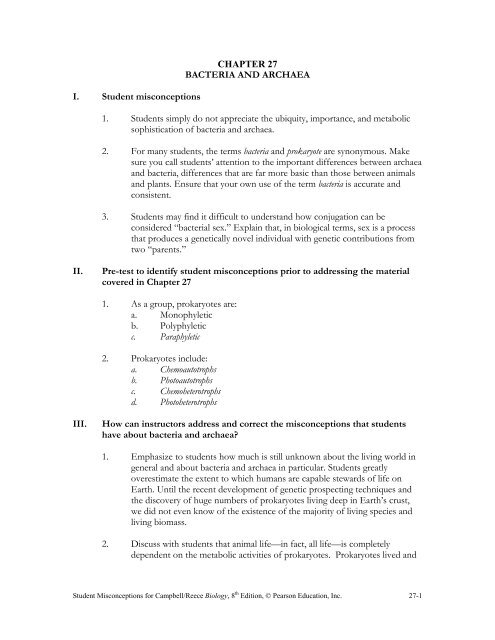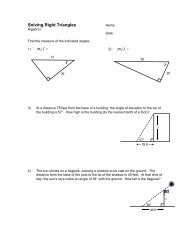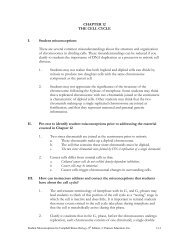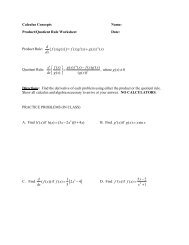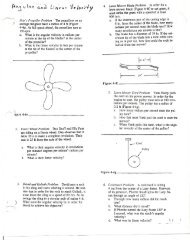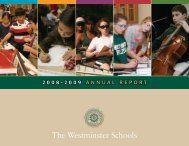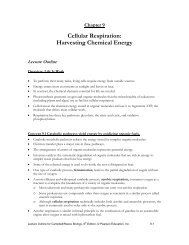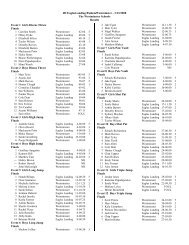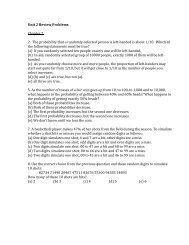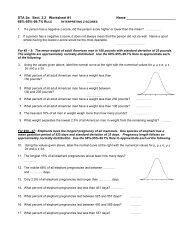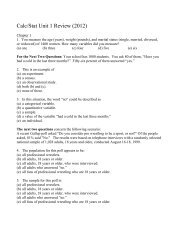CHAPTER 27 BACTERIA AND ARCHAEA I. Student misconceptions ...
CHAPTER 27 BACTERIA AND ARCHAEA I. Student misconceptions ...
CHAPTER 27 BACTERIA AND ARCHAEA I. Student misconceptions ...
You also want an ePaper? Increase the reach of your titles
YUMPU automatically turns print PDFs into web optimized ePapers that Google loves.
I. <strong>Student</strong> <strong>misconceptions</strong><strong>CHAPTER</strong> <strong>27</strong><strong>BACTERIA</strong> <strong>AND</strong> <strong>ARCHAEA</strong>1. <strong>Student</strong>s simply do not appreciate the ubiquity, importance, and metabolicsophistication of bacteria and archaea.2. For many students, the terms bacteria and prokaryote are synonymous. Makesure you call students’ attention to the important differences between archaeaand bacteria, differences that are far more basic than those between animalsand plants. Ensure that your own use of the term bacteria is accurate andconsistent.3. <strong>Student</strong>s may find it difficult to understand how conjugation can beconsidered “bacterial sex.” Explain that, in biological terms, sex is a processthat produces a genetically novel individual with genetic contributions fromtwo “parents.”II.Pre-test to identify student <strong>misconceptions</strong> prior to addressing the materialcovered in Chapter <strong>27</strong>1. As a group, prokaryotes are:a. Monophyleticb. Polyphyleticc. Paraphyletic2. Prokaryotes include:a. Chemoautotrophsb. Photoautotrophsc. Chemoheterotrophsd. PhotoheterotrophsIII.How can instructors address and correct the <strong>misconceptions</strong> that studentshave about bacteria and archaea?1. Emphasize to students how much is still unknown about the living world ingeneral and about bacteria and archaea in particular. <strong>Student</strong>s greatlyoverestimate the extent to which humans are capable stewards of life onEarth. Until the recent development of genetic prospecting techniques andthe discovery of huge numbers of prokaryotes living deep in Earth’s crust,we did not even know of the existence of the majority of living species andliving biomass.2. Discuss with students that animal life—in fact, all life—is completelydependent on the metabolic activities of prokaryotes. Prokaryotes lived and<strong>Student</strong> Misconceptions for Campbell/Reece Biology, 8 th Edition, © Pearson Education, Inc. <strong>27</strong>-1
evolved alone on Earth for well over a billion years. Eukaryotes would likelynot survive a year in the absence of prokaryotes.3. Many students think of evolution as progressive, and they view multicellulareukaryotes as “advanced” and thus far more capable than prokaryotes. Referto this misconception when introducing nitrogen-fixing cyanobacteria as themost self-sufficient of all organisms, requiring only light energy, CO 2 , N 2 ,water, and some minerals to grow. With very few exceptions, all metabolicpathways evolved in prokaryotic organisms. Prokaryotes—especiallybacteria—are far more metabolically diverse than eukaryotes.4. As you teach students about bacteria and archaea, it is important toemphasize what recent findings have taught us about these abundant andcapable organisms: that they live everywhere; that they are metabolically,structurally, and biochemically diverse; and that their biomass is an order ofmagnitude greater than the biomass of eukaryotes.IV.Post-test to identify whether students have corrected their <strong>misconceptions</strong>1. Human life is dependent on the activities of prokaryotic organisms. Describethree examples to illustrate this statement. At least one of the examples mustbe a mutualistic relationship.2. “Nitrogen-fixing cyanobacteria are far more self-sufficient than any animal.”Explain what this statement means.V. ReferenceGould, S. J. (1996). The planet of the bacteria, The Washington Post, November 13.(Available at: http://www.stephenjaygould.org/library/gould_bacteria.html)<strong>Student</strong> Misconceptions for Campbell/Reece Biology, 8 th Edition, © Pearson Education, Inc. <strong>27</strong>-2


